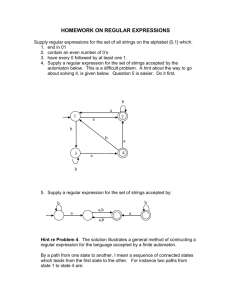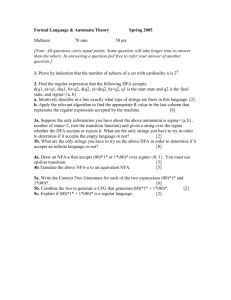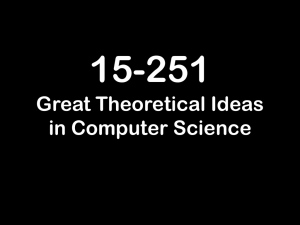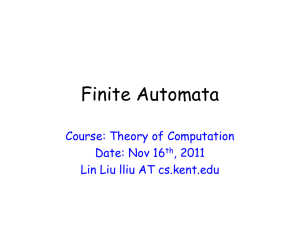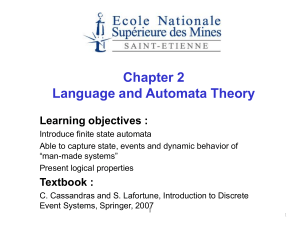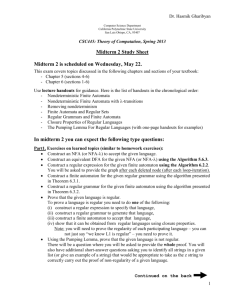Introduction to Computability Theory
advertisement
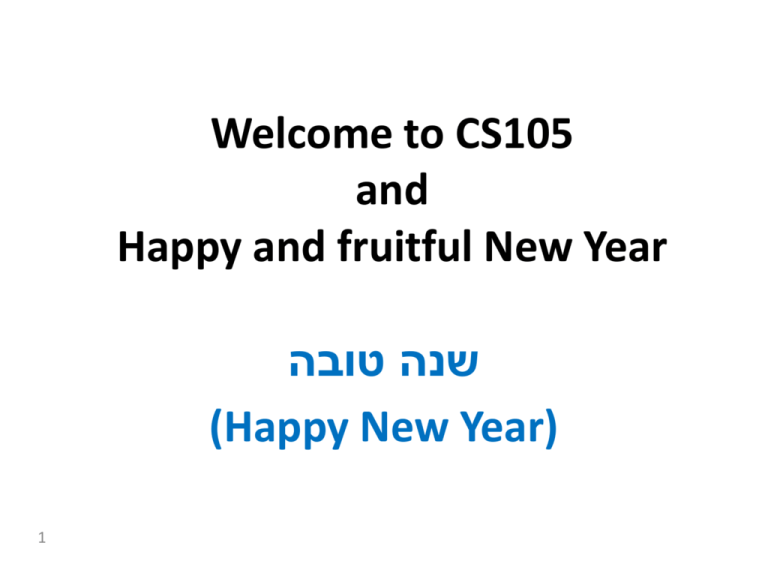
Welcome to CS105
and
Happy and fruitful New Year
שנה טובה
(Happy New Year)
1
Staff
Instructor: Amos Israeli room 2-106 .
Office Hours: Fri 10-12 or by arrangement
Tel#: 534-886
e-mail: aisraeli “at” cs.ucsd.edu
TA: Scott Yilek room B-240a
Office Hours: Mon 4-5:30
e-mail: syilek “at” cs.ucsd.edu
• Web Page:
http://www.cse.ucsd.edu/classes/fa08/cse105
2
Meeting Times
Lectures: Tue, Thu 3:30p - 4:50p WLH 2111
Note: Thu Oct 9 Lecture is canceled, there
may be a make-up lecture by quarter’s end.
Sections: Mon, 1:00p - 1:50p WLH 2209 – Scott
Tue, 3:00p - 3:50p WLH 2209 – Amos
Note: Students should come to both sections.
Mid-term: Thu Oct 23 3:30p WLH 2111
Final: Tue Dec 9 11:30a - 2:20p TBA
3
Homework
There will be 5-6 assignments.
Assignments will be given on Monday’s section
and must be returned by the Thu lecture one
week later.
First assignment will be given next Monday and
must be returned on Wed Oct 8 or in Scott’s
mailbox on Thu Oct 9th.
4
Academic Integrity
• You are encouraged to discuss the
assignments problems among yourselves.
• Each student must hand in her/his own
solution.
• You must Adhere to all rules of Academic
Integrity of CS Dept. UCSD and others.
(Meaning: no cheating or copying from any
source)
5
Grading
• Assignments: 20%
• Midterm: 30% - 0% (students are allowed to
drop it), open book, open notes.
• Final: 50% - 80%, open book, open notes.
6
Grading
•
•
•
•
•
7
A: (85-100)
B: (70-84)
C: (55-69)
D: (40-54)
F: (0-39)
Bibliography
Required: Michael Sipser: Introduction to the
Theory of Computation, Second Edition,
Thomson.
8
Introduction to Computability
Theory
Lecture1: Finite Automata and Regular
Languages
Prof. Amos Israeli
)(פרופ' עמוס ישראלי
9
Introduction
Computer Science stems from two starting
points:
Mathematics: What can be computed?
And what cannot be computed?
Electrical Engineering: How can we build
computers?
Not in this course.
10
Introduction
Computability Theory deals with the profound
mathematical basis for Computer Science, yet
it has some interesting practical ramifications
that I will try to point out sometimes.
The question we will try to answer in this course
is:
“What can be computed? What Cannot be
computed and where is the line between the
two?”
11
Computational Models
A Computational Model is a mathematical
object (Defined on paper) that enables us to
reason about computation and to study the
properties and limitations of computing.
We will deal with Three principal computational
models in increasing order of Computational
Power.
12
Computational Models
We will deal with three principal models of
computations:
1. Finite Automaton (in short FA).
recognizes Regular Languages .
2. Stack Automaton.
recognizes Context Free Languages .
3. Turing Machines (in short TM).
recognizes Computable Languages .
13
Alan Turing - A Short Detour
Dr. Alan Turing is one of the founders of Computer
Science (he was an English Mathematician).
Important facts:
1. “Invented” Turing machines.
2. “Invented” the Turing Test.
3. Broke the German submarine transmission
coding machine “Enigma”.
4. Was arraigned for being gay and committed
suicide soon after.
14
Finite Automata - A Short Example
• The control of a washing machine is a very
simple example of a finite automaton.
• The most simple washing machine accepts
quarters and operation does not start until at
least 3 quarters were inserted.
Thanks: Vadim Lyubasehvsky
Now on PostDoc in Tel-Aviv
Finite Automata - A Short Example
• The control of a washing machine is a very
simple example of a finite automaton.
• The most simple washing machine accepts
quarters and operation does not start until at
least 3 quarters were inserted.
• The second washing machine accepts 50 cents
coins as well.
Finite Automata - A Short Example
• The control of a washing machine is a very
simple example of a finite automaton.
• The most simple washing machine accepts
quarters and operation does not start until at
least 3 quarters were inserted.
• The second washing machine accepts 50 cents
coins as well.
• The most complex washing machine accepts
$1 coins too.
Finite Automaton - An Example
0
q0
0,1
q1
0,1
qs
1
States:
Q {qs , q0 , q1}
Initial State:
Final State:
21
qs
q0
,
,
Finite Automaton – An Example
0
q0
0,1
q1
0,1
qs
1
Transition Function: qs ,0 q0 qs ,1 q1
q0 ,0 q0 ,1 q0
q1,0 q1,1 q1
,
Alphabet: 0,1. Note: Each state has all transitions .
,
22
Accepted words: 0,00,01,000,001,...
Finite Automaton – Formal Definition
A finite automaton is a 5-tupple Q, , , q0 , F
where:
1. Qis a finite set called the states.
2. is a finite set called the alphabet.
3. : Q Q is the transition function.
4. q0 Q is the start state, and
,
5. F Q is the set of accept states.
,
23
Observations
1. Each state has a single transition for each
symbol in the alphabet.
2. Every FA has a computation for every finite
string over the alphabet.
,
,
24
Examples
1. M accepts all words (strings) ending with 1.
2
The language recognized by M , called
2
LM 2 satisfies: LM 2 w | w ends with 1 .
25
How to do it
1. Find some simple examples (short accepted and
rejected words)
2. Think what should each state “remember”
(represent).
3. Draw the states with a proper name.
4. Draw transitions that preserve the states’
“memory”.
5. Validate or correct.
6. Write a correctness argument.
The automaton
Correctness Argument:
The FA’s states encode the last input bit and
is the only accepting state. The transition
function preserves the states encoding.
q1
Examples
1. M accepts all words (strings) ending with 1.
2
.
LM 2 w | w ends with 1
2. M 3 accepts all words ending with 0.
2’. M 4 accepts all words ending with 0 and
the empty word
.
This is the Complement Automaton of M 2 .
28
Examples
1. M 2 accepts all words (strings) ending with 1.
LM 2 w | w ends with 1 .
2. M 3 accepts all words ending with 0.
3. M 4 accepts all strings over alphabet
a, b
that start and end with the same symbol .
29
Examples (cont)
4. M 5 accepts all words of the form 0m1n
where m, n are integers and m, n 0 .
5. M 6 accepts all words in 0,1,00,01,10.
30
Languages
• Definition: A language is a set of strings over
some alphabet .
• Examples:
– L1 0,1,10,1110001
–
L2 0m1n | n, m are positive integers
bit strings whose binary
– L3
value is a multiple of 4
31
Languages
• A language of an FA, M , LM , is the set of
words (strings) that M accepts.
• If La LM we say that M recognizes La .
• If La is recognized by some finite
,
automaton A , La is a Regular Language.
32
Some Questions
Q1: How do you prove that a language La is regular?
A1: By presenting an FA, M , satisfying La LM .
Q2: How do you prove that a language La is not
regular?
A2: Hard! to be answered on Week3 of the course.
Q3: Why is it important?
A3: Recognition of a regular language requires a
controller with bounded Memory.
33
The Regular Operations
Let A and B be 2 regular languages above the
same alphabet, . We define the 3 Regular
Operations:
• Union: A B x | x A or x B .
• Concatenation: A B xy | x A and y B .
• Star: A* x1 , x2 ,..., xk | k 0 and xk A .
34
The Regular Operations
• given a language one can verify it is regular by
presenting an FA that accept the language.
• Regular Operations give us a systematic way of
constructing languages that are apriority
regular. (That is: No verification is required).
35
The Regular Operations - Examples
A good , bad B girl, boy
• A B good , bad , girl , boy
• A B goodgirl , goodboy, badgirl
. , badboy
, good , bad , goodgood , goodbad ,
• A
.
goodgoodgoodbad , badbadgoodbad ,...
*
36
Theorem
The class of Regular languages, above the same
alphabet, is closed under the union operation.
Meaning: The union of two regular languages
is Regular.
.
37
Example
Consider L1 w | w starts with 1, and
L2 w | w ends with 0 .
The union set is the set of all bit strings that
either start with 1, or end with 0.
Each of these sets can be recognized by an FA
with 3 states.
Can you construct an FA that recognizes the
union set?
Proof idea
If A1 and A2 are regular, each has its own
recognizing automaton N1 and N 2 ,
respectively.
In order to prove that the language A1 A2 is
regular we have to construct an FA that
accepts exactly the words in A1 A2 .
Note: cannot apply
39
N1 followed by N 2 .
Proof idea
• We construct an FA that simulates the
computations of, N1 and N 2 simultaneously.
• Each state of the simulating FA represents a
pair of states of N1 and of N 2
respectively.
• Can you define the transition function and the
final state(s) of the simulating FA?
40
Wrap up
In this talk we:
1. Motivated the course.
2. Defined Finite Automata (Latin Pl. form of
automaton).
3. Learned how to deal with construction of
A
1
automata and how to come up with a
correctness argument.
41


